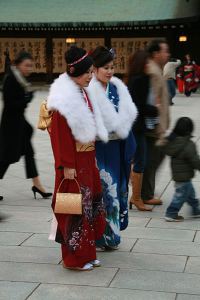Art of Japan and Tokyo Ladies: Ghosts of the Past Remain within A Living Tradition
Tomoko Hara
Modern Tokyo Times
Ukiyo-e art in Japan focused on many themes during its “golden period” in the Edo period and this was replicated during the Meiji era. Therefore, the world of old Japan comes alive visually within many areas of ukiyo-e art because of the subjects covered. It matters not if this art applies to the rich cultural aspects of Japan or the floating world which was truly dramatic.
Sometimes in modern Tokyo and throughout Japan you will see ladies in traditional Japanese clothes during special occasions. When this happens it is often like “looking into a mirror of ukiyo-e” and seeing “a ghost from the past.” However, this “mirror” and “ghost” is truly part of the modern Japan.
This in itself highlights the richness of ukiyo-e in the field of showing traditional ladies in their splendid best. It is also evidence that while Japan is ultra modern, the old world remains powerful even if within “mirages” of the original meaning. Either way, if based on tradition or “mirages,” it is still a noteworthy connection with the past.
Ogata Gekko produced many stunning images of elegant ladies posing in tradition dress. Of course, countless other amazing ukiyo-e artists also focused on the same theme. Therefore, the richness of ukiyo-e art depicts many images of art related to women. This applies to high culture, erotic art (shunga), beautiful ladies (bijinga), ghosts and other themes that are covered within the world of Japanese woodblock prints and the floating world of ukiyo-e.
Lee Jay Walker at Modern Tokyo says: “The real power in these images, I believe, applies to simplicity and how space, time, cultural richness and modern Japanese women were being portrayed. Indeed, the ideal image in a sense can still be seen in modern Japan when ladies dress in traditional styles. This can be seen clearly because a lot of thought, high quality materials, color schemes and other important areas are connecting with the world of Japanese woodblock prints and the floating world of ukiyo-e”
Lee Jay Walker further states: “The world of Ogata Gekko, like many other artists during the same time period, witnessed many changes because of the onset of modernity. However, if he was to come back today, then he would witness glimpses of the old world that connects the dying days of Edo and the new world of Meiji. Likewise, Torii Kiyonaga (1752-1815) excelled in the area of bijinga because of his amazing details and intricacies.”
Torii Kiyonaga is one of the many amazing artists that belonged to the Torii school of art. He emphasized many aspects of women and traditional dress. This applies to high culture, stratification, sexuality, morality, natural elegance, shunga, bijinga and other important areas. The art of Torii Kiyonaga is widely appreciated and when viewing his art related to bijinga and seeing a modern lady in traditional dress in Japan, it is easy to connect both together.
Torii Kiyonaga also highlighted exquisite color schemes and amazing embroidery. This aspect of his art would also fit in naturally within elegant boutiques in modern day Japan. The special detail and attention given by this amazing artist meant that he depicted elegant and refined ladies.. Therefore, during special occasions in modern day Japan you can see aspects of the world of ukiyo-e artists in relation to traditional Japanese dress.
In places like the Meiji shrine in Harajuku and sophisticated parts of Japan that focus on tradition like Kyoto, Nara, Nikko, and many other parts of this fascinating nation, the old world and new world can be witnessed. In a sense, you can peer into the world of ukiyo-e artists and this notably applies to areas related to bijinga and traditional dress styles. The ghosts of the past therefore remain within “a living tradition” that comes alive during special occasions – or in specific parts of Japan where high culture and tradition remains strong, then the old world survives in relation to the depiction of women even if the meaning may have changed.
Lee Jay Walker gave guidance to Tomoko Hara
Modern Tokyo News is part of the Modern Tokyo Times group
DONATIONS to SUPPORT MODERN TOKYO TIMES – please pay PayPal and DONATE to sawakoart@gmail.com
http://moderntokyotimes.com Modern Tokyo Times – International News and Japan News
http://sawandjay.com Modern Tokyo Times – Fashion
http://moderntokyonews.com Modern Tokyo News – Tokyo News and International News
http://global-security-news.com Global Security News – Geopolitics and Terrorism
PLEASE JOIN ON TWITTER
https://twitter.com/MTT_News Modern Tokyo Times
PLEASE JOIN ON FACEBOOK
https://www.facebook.com/moderntokyotimes
Some Japanese art and cultural articles by Modern Tokyo Times are republished based on the need to inform our growing international readership about the unique reality of Japan.





